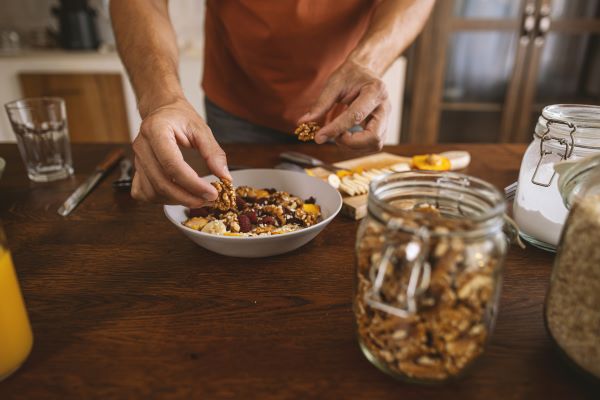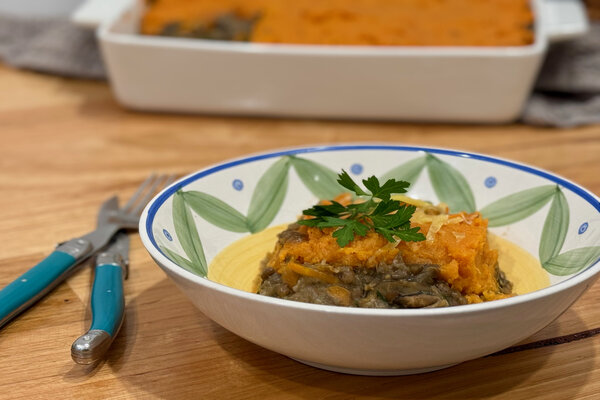-
From our social media feeds to our supermarket shelves, you can’t escape the feeling that we all need to eat more protein.
It’s surprising to learn then that vast majority of people actually meet their daily protein requirements.1
So, what’s behind the protein hype? Advanced Accredited Dietitian and co-founder of OnCore Nutrition, Lauren Atkins, suggests it may be that there are no perceived downsides to protein.
“Protein is an important part of a balanced diet, but so are healthy fats and carbohydrates. Unfortunately I think fats and carbohydrates have been demonized for many years, whereas protein has not,” she says.
We spoke to her about the importance of protein, and how much we really need to survive and thrive.
Understanding macronutrients
Before we delve into the details on protein, it’s helpful to understand the broader context around macronutrients.
There are three main macronutrients that our body needs to function – carbohydrates, fats and proteins. These macronutrients all provide our body with energy, but they all have unique functions.
“Protein is well-known for its role in muscle maintenance and growth, and it is absolutely essential for our muscle health,” says Lauren.
“But it also plays an important role in other areas, for example, our hormones are made up of proteins, and so are the enzymes that our body uses to break down food.”
The other macronutrients play important roles as well – carbohydrates, in foods such as wholegrains and vegetables, are essential for our gut health, and healthy fats play an important role in heart and brain health and reducing inflammation (amongst other things).
Getting a balance of macronutrients is important. In fact, there is a growing body of research that suggests a major imbalance in these macronutrients can increase your risk of chronic disease.2
How much protein do you need each day?
The amount of protein you need varies depending on factors like your age, gender, health goals, and health conditions.
“You and I might be very similar age, body shape, size, activity level, but I might want to build muscle and be stronger and you might be comfortable as you are. So our protein requirements would differ,” says Lauren.
While we will all have unique needs, there are some general guidelines around protein intake.
Average person
The recommendation for an average woman is 0.75 grams of protein per kilo of body weight per day and 0.84 grams of protein per kilo of body weight for men.3
“Eating enough protein is actually quite easy, and most of us reach our daily recommendation without thinking about it. Incorporating protein-rich foods like lean meat, poultry, fish, eggs, dairy, nuts, seeds and legumes will be enough for most people,” says Lauren.
READ MORE: 5 healthy sources of protein for a balanced diet
If your goal is to build muscle
Research indicates people who want to build muscle and strength should aim for 1.6 grams of protein per kilo of body weight.4 But, Lauren stresses the importance of matching that increased protein intake with the right level of movement.
“Eating protein without putting physical strain on our body does not equate to muscle mass gain. You actually have to utilise the muscle to get strength gains,” she says.
Maintaining muscle after menopause
Starting from around the age of 40, our muscle mass naturally declines. Combined with the hormonal changes that occur during perimenopause and menopause, it makes it harder to maintain muscle mass, which is important for everyday functioning and longevity, including bone health.
“Research suggests 1-1.2 grams of protein per kilo of body weight per day is important for women who want to maintain muscle function and health, paired with the right amount of exercise,” says Lauren.5
Maintaining muscle after 60
When we reach our 60s and 70s, we tend to lose muscle mass more rapidly.
To minimise the impact of this natural, age-related decline in muscle mass (a process called sarcopenia) and maintain strength, older adults need more protein, says Lauren.
“Research suggests an intake of about 1.0 to 1.2 grams per kilogram of body weight per day, which is significantly higher than the standard recommendations for younger adults,” she said, again highlighting the importance of combining diet and exercise to achieve the best results.5,6
If your goal is to lose weight
You may have heard that increasing your protein intake is effective for weight loss, and there are a number of reasons behind that, says Lauren:
- Protein makes you feel full: “Protein is very satiating, so in theory it means we should feel fuller more quickly and eat to our appetite – not beyond!”
- It takes more energy to break down: “Protein requires more energy for the body to break down protein, compared to other macronutrients.”
- It can help reduce blood sugar and insulin spikes: Pairing protein-rich foods with a carbohydrate can slow the glycaemic response which is important for energy levels and hunger cues. “For example, if you pair some quality Greek yoghurt, which is high in protein, with a baked potato, it will slow down your glycaemic response and you won’t get that blood sugar and insulin spike,” says Lauren.
If your goal is to lose weight, Lauren recommends taking the focus off counting or calculating grams of protein, and instead aiming to include a palm-sized serve of a protein at each meal across the day.
How much protein do you really need?


Eat better, get rewarded.
You could earn points for your healthy eating habits with Live Better rewards, be it eating more fruit and vegetables, drinking more water or even cutting down on sugar! Then redeem it for exciting rewards from partners like HelloFresh, THE ICONIC and more.
For eligible Medibank members with hospital and/or extras cover only. T&Cs apply.
-
Can you have too much protein?
Excess protein can be stored as fat, and eating too much can potentially put a strain on your kidneys, particularly if it is coming from animal proteins like meat and eggs.
“There are very few instances where you would need more than two grams of protein per kilo per day, and I'd be cautious of intakes above that level,” says Lauren.8
A balanced approach is important
It’s important to think about our diet holistically, given most of us don’t get enough fruit and vegetables in our diet.
“If your steak or chicken breast is taking up half of your plate, think about what that means you are missing out on,” says Lauren. “It’s usually all of those healthy whole grains and vegetables that are essential for our brain and gut health.”
One way to create a balanced meal is to consider how much room each element takes up on your plate. Aim to include around:
- ¼ of a plate of healthy protein like lean meats, poultry, fish, eggs, legumes, tofu and nuts
- ½ plate of non-starchy, colourful fruits and vegetables like spinach, carrots, broccoli, eggplant and capsicum
- ¼ plate of whole grains like grainy bread, brown basmati rice or wholegrain pasta
- Sprinkle in some dairy and healthy fats like extra virgin olive oil, avocado or cheese
- Add a glass of water or herbal tea
When should you eat protein?
It’s best to spread your protein across the day, says Lauren.
“Aim to include some high-quality protein at each meal, rather than stacking it all at dinner. Having your protein supply spaced out through the day has been shown to be beneficial for our muscle mass synthesis, as well as keeping you feeling full and satisfied throughout the day.”7
While it may be easy to include protein with lunch or dinner, breakfast can be more challenging. “Try incorporating foods like eggs, nuts, seeds and Greek yoghurt,” says Lauren.
Tailored advice to meet your goals
It’s easy to be confused about diet in a world where we are constantly bombarded with health claims and advice.
“There is so much information out there and a lot of it is misleading,” says Lauren. “Seeking help from an Accredited Practising Dietitian can help you understand your unique needs, and reach your goals far more effectively.”
READ MORE: Dietitian, nutritionist or naturopath. What’s the difference?

Stretch your extras further.
With over 550 Members’ Choice Advantage physio provider practices Australia wide, our Members’ Choice Advantage physiotherapy network generally offers members greater value from their Extras cover, with capped fees to help reduce out-of-pocket expenses*~
-
Training? Expert tips to help you get your nutrition right
Top nutrition tips for women training for a run, race or sporting event, according to an expert.
-
Fuel your body at any age
Nutrition tips for women who want to stay active at all stages of life, straight from a sports dietitian.
-
How to keep your iron levels up as an active woman
Iron deficiency – and sometimes anaemia – can be a common problem for active women. Here’s how to help ensure you’re getting enough iron.
-
Eating for your brain health
Accredited Practising Dietitian Laura Thomas discusses the best diet for supporting brain health and her top tips for adopting brain-healthy eating habits.
-
5 healthy proteins for a balanced diet
An Accredited Practising Dietitian shares her top protein sources for a balanced diet, and some less useful ones to consider replacing. Plus, she explains the difference between animal and plant proteins.
-
Vegetarian shepherd’s pie recipe
Cozy up with this hearty vegetarian shepherd’s pie packed with veggies.
References
1. Australian Bureau of Statistics, 2015, Australian Health Survey: Usual Nutrient intakes
2. Eat for Health, Macronutrient balance | Eat For Health
3. Eat for Health, 2006, Nutrient reference values for Australia and New Zealand - Protein
4. Morton, R.W. et al., (2017). A systematic review, meta-analysis and meta-regression of the effect of protein supplementation on resistance training-induced gains in muscle mass and strength in healthy adults. British Journal of Sports Medicine, [online] 52(6), pp.376–384. 4
5. Bauer, J. et al., (2013). Evidence-Based Recommendations for Optimal Dietary Protein Intake in Older People: a Position Paper from the PROT-AGE Study Group. Journal of the American Medical Directors Association, [online] 14(8), pp.542–559.
6. Volkert, D., Beck, A. M., Cederholm, T., Cruz-Jentoft, A., Goisser, M., Hooper, L., ... & Valentini, L. (2022). ESPEN guideline on clinical nutrition and hydration in geriatrics. Clinical Nutrition, 41(4), 1010-1042.
7. Mamerow, M. M., Mettler, J. A., English, K. L., Casperson, L. J., Arentson-Lantz, E., Sheffield-Moore, L., ... & Paddon-Jones, D. (2014). Dietary protein distribution positively influences daily muscle protein synthesis in older adults. The Journal of Nutrition, 144(6), 876-880.
8. Wu, G. (2016). Dietary protein intake and human health. Food & Function, 7(3), 1251-1265.
Things you should know
Must be 16 years or over to register for Medibank Live Better rewards. Some program partners and earning activities require a person to be at least 18 years of age to be eligible to earn and/or redeem a reward. Must be a Medibank member with hospital cover, extras cover, or hospital and extras cover, be up-to-date with premium payments and have signed up to Medibank Live Better rewards in the My Medibank app to earn Live Better points for eligible purchases and redeem rewards. Excludes Overseas Student Health Cover (OSHC), Ambulance only cover, ahm covers and other selected covers. Live Better Management Pty Ltd, ACN 003 457 289 has entered into commercial arrangements with Medibank Live Better program partners and may receive commissions. Additional terms and conditions may apply to points earning activities and rewards. Points earning activities and rewards are subject to change and may be subject to availability. Wherever possible, we will give you notice of these changes. See full Medibank Live Better rewards terms.
Medibank Live Better Challenges & Goals Earning Policy: The participant of a Medibank Live Better Challenge or Goal may not receive Live Better points or may have their already credited Live Better points reversed in accordance with the Medibank Live Better terms and conditions. To earn Live Better points, the participant needs to properly complete 100% of the eligible Challenge according to the instructions. The number of Live Better points available for Medibank Live Better Challenges and Goals is subject to change without prior notice. The maximum number of Live Better points that each Medibank Live Better member can earn from successfully completing health and wellbeing Challenges, Goals or any Onboarding action in a calendar year is 40,000 Live Better points. To the extent of any inconsistency between this Policy and the Medibank Live Better terms and conditions, the terms and conditions will take precedence.
*Waiting periods apply.
~Members' Choice providers are not available in all areas and may change without notice.





